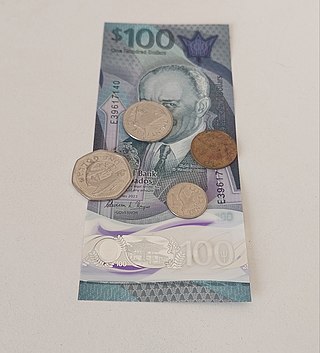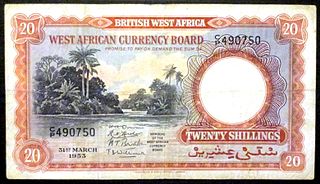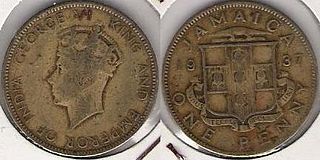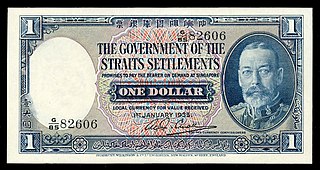Related Research Articles
The Eastern Caribbean dollar is the currency of all seven full members and one associate member of the Organisation of Eastern Caribbean States (OECS). The successor to the British West Indies dollar, it has existed since 1965, and it is normally abbreviated with the dollar sign $ or, alternatively, EC$ to distinguish it from other dollar-denominated currencies. The EC$ is subdivided into 100 cents. It has been pegged to the United States dollar since 7 July 1976, at the exchange rate of US$1 = EC$2.70.

The Belize dollar is the official currency in Belize. It is normally abbreviated with the dollar sign $, or alternatively BZ$ to distinguish it from other dollar-denominated currencies.
The British West Indies dollar (BWI$) was the currency of British Guiana and the Eastern Caribbean territories of the British West Indies from 1949 to 1965, when it was largely replaced by the East Caribbean dollar, and was one of the currencies used in Jamaica from 1954 to 1964. The monetary policy of the currency was overseen by the British Caribbean Currency Board (BCCB). It was the official currency used by the West Indies Federation The British West Indies dollar was never used in British Honduras, the Cayman Islands, the Turks and Caicos Islands, the Bahamas, or Bermuda.
The Bermudian dollar is the official currency of the British Overseas Territory of Bermuda. It is subdivided into 100 cents. The Bermudian dollar is not normally traded outside Bermuda, and is pegged to the United States dollar at a one-to-one ratio. Both currencies circulate in Bermuda on an equal basis.

The Jamaican dollar has been the currency of Jamaica since 1969. It is often abbreviated to J$, the J serving to distinguish it from other dollar-denominated currencies. It is divided into 100 cents, although cent denominations are no longer in use as of 2018. Goods and services may still be priced in cents, but cash transactions are now rounded to the nearest dollar.

The Trinidad and Tobago dollar is the currency of Trinidad and Tobago. It is normally abbreviated with the dollar sign $, or alternatively TT$ to distinguish it from other dollar-denominated currencies. It is subdivided into 100 cents. Cents are abbreviated with the cent sign ¢, or TT¢ to distinguish from other currencies that use cents. Its predecessor currencies are the Trinidadian dollar and the Tobagonian dollar.

The Guyanese dollar has been the unit of account in Guyana since 29 January 1839. Originally it was intended as a transitional unit to facilitate the changeover from the Dutch guilder system of currency to the British pound sterling system. The Spanish dollar was already prevalent throughout the West Indies in general, and from 1839, the Spanish dollar unit operated in British Guiana in conjunction with British sterling coins at a standard conversion rate of one dollar for every four shillings and twopence. In 1951 the British sterling coinage was replaced with a new decimal coinage which was simultaneously introduced through all the British territories in the Eastern Caribbean. When sterling began to depreciate in the early 1970s, a switch to a US dollar peg became increasingly attractive as an anti-inflationary measure and the Eastern Caribbean Currency Authority made the switch in October 1975. The Guyanese dollar is normally abbreviated with the dollar sign $, or alternatively G$ to distinguish it from other dollar-denominated currencies.

The dollar has been the currency of Barbados since 1935. Globally its currency has the ISO 4217 code BBD, however, unofficially in Barbados the International vehicle registration code BDS is also commonly used, a currency code that is otherwise reserved for Bangladesh outside Barbados. As such the present dollar has the ISO 4217 code BBD. The Barbadian dollar is divided into 100 cents.

The pound was the currency of British West Africa, a group of British colonies, protectorates and mandate territories. It was equal to one pound sterling and was similarly subdivided into 20 shillings, each of 12 pence.

The pound was the official currency of Jamaica between 1840 and 1969. It circulated as a mixture of sterling coinage and locally issued coins and banknotes and was always equal to the pound sterling. The Jamaican pound was also used in the Cayman and Turks and Caicos Islands.

The Straits dollar was the currency of the Straits Settlements from 1898 until 1939. At the same time, it was also used in the Federated Malay States, the Unfederated Malay States, Kingdom of Sarawak, Brunei, and British North Borneo.

Canada has an extensive history with regard to its currencies. Prior to European contact, indigenous peoples in Canada used items such as wampum and furs for trading purposes, which continued when trade with Europeans began. During the period of French colonization, coins were introduced, as well as one of the first examples of paper currency by a western government. During the period of British colonization, additional coinage was introduced, as well as banknotes. The Canadian colonies gradually moved away from the British pound and adopted currencies linked to the United States dollar. With Confederation in 1867, the Canadian dollar was established. By the mid-20th century, the Bank of Canada was the sole issuer of paper currency, and banks ceased to issue banknotes.
The pound was the currency of Bermuda until 1970. It was equivalent to sterling, alongside which it circulated, and was similarly divided into 20 shillings each of 12 pence. Bermuda decimalised in 1970, replacing the pound with the Bermudian dollar at a rate of $1 = 8s.4d., equal to the US dollar.
The history of currency in the British colony of Dominica closely follows that of the British Eastern Caribbean territories in general. Even though Queen Anne's proclamation of 1704 brought the gold standard to the West Indies, silver pieces of eight continued to form a major portion of the circulating currency right into the latter half of the nineteenth century.
The history of currency in the British colony of Grenada closely follows that of the British Eastern Caribbean territories in general. Even though Queen Anne's proclamation of 1704 brought the gold standard to the West Indies, silver pieces of eight continued to form a major portion of the circulating currency right into the latter half of the nineteenth century.
The history of currency in the British colony of St. Kitts closely follows that of the British Eastern Caribbean territories in general. Even though Queen Anne's proclamation of 1704 brought the gold standard to the West Indies, silver pieces of eight continued to form a major portion of the circulating currency right into the latter half of the nineteenth century.
The history of currency in the British colony of Saint Vincent closely follows that of the British Eastern Caribbean territories in general. As such, it should not be considered in isolation. In order to get a broad overview of currency in the region, see the article British West Indies dollar.
The history of currency in the British colony of Saint Lucia closely follows that of the British Eastern Caribbean territories in general. Even though Queen Anne's proclamation of 1704 brought the gold standard to the West Indies, silver pieces of eight continued to form a major portion of the circulating currency right into the latter half of the nineteenth century.
The region known as the British West Indies included British Guiana on the South American mainland, British Honduras in Central America, Bermuda, The Bahamas, and Jamaica, along with its former dependencies of the Cayman Islands and the Turks and Caicos Islands. It also included the Eastern Caribbean territories of Trinidad and Tobago, Barbados, the Windward Islands and the Leeward Islands.
Sterling was the currency of many, but not all parts of the British Empire. This article looks at the history of sterling in the Australia, New Zealand, and Pacific region.
References
- Pick, Albert (1990). Standard Catalog of World Paper Money: Specialized Issues. Colin R. Bruce II and Neil Shafer (editors) (6th ed.). Krause Publications. ISBN 0-87341-149-8.